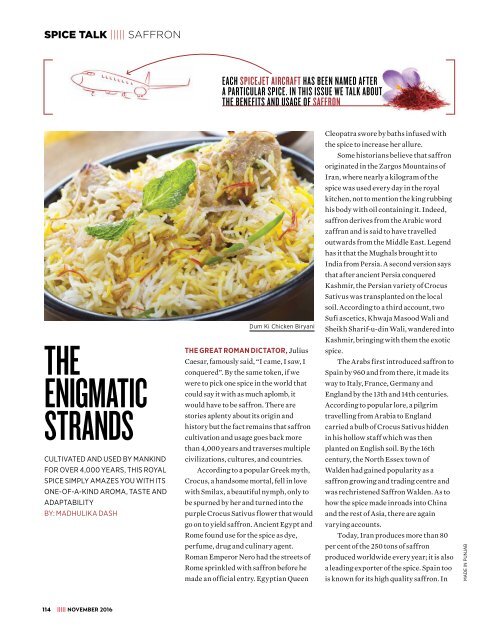You also want an ePaper? Increase the reach of your titles
YUMPU automatically turns print PDFs into web optimized ePapers that Google loves.
SPICE TALK ||||| SAFFRON<br />
EACH SPICEJET AIRCRAFT HAS BEEN NAMED AFTER<br />
A PARTICULAR SPICE. IN THIS ISSUE WE TALK ABOUT<br />
THE BENEFITS AND USAGE OF SAFFRON<br />
THE<br />
ENIGMATIC<br />
STRANDS<br />
CULTIVATED AND USED BY MANKIND<br />
FOR OVER 4,000 YEARS, THIS ROYAL<br />
SPICE SIMPLY AMAZES YOU WITH ITS<br />
ONE-OF-A-KIND AROMA, TASTE AND<br />
ADAPTABILITY<br />
BY: MADHULIKA DASH<br />
Dum Ki Chicken Biryani<br />
THE GREAT ROMAN DICTATOR, Julius<br />
Caesar, famously said, “I came, I saw, I<br />
conquered”. By the same token, if we<br />
were to pick one spice in the world that<br />
could say it with as much aplomb, it<br />
would have to be saffron. There are<br />
stories aplenty about its origin and<br />
history but the fact remains that saffron<br />
cultivation and usage goes back more<br />
than 4,000 years and traverses multiple<br />
civilizations, cultures, and countries.<br />
According to a popular Greek myth,<br />
Crocus, a handsome mortal, fell in love<br />
with Smilax, a beautiful nymph, only to<br />
be spurned by her and turned into the<br />
purple Crocus Sativus flower that would<br />
go on to yield saffron. Ancient Egypt and<br />
Rome found use for the spice as dye,<br />
perfume, drug and culinary agent.<br />
Roman Emperor Nero had the streets of<br />
Rome sprinkled with saffron before he<br />
made an official entry. Egyptian Queen<br />
Cleopatra swore by baths infused with<br />
the spice to increase her allure.<br />
Some historians believe that saffron<br />
originated in the Zargos Mountains of<br />
Iran, where nearly a kilogram of the<br />
spice was used every day in the royal<br />
kitchen, not to mention the king rubbing<br />
his body with oil containing it. Indeed,<br />
saffron derives from the Arabic word<br />
zaffran and is said to have travelled<br />
outwards from the Middle East. Legend<br />
has it that the Mughals brought it to<br />
India from Persia. A second version says<br />
that after ancient Persia conquered<br />
Kashmir, the Persian variety of Crocus<br />
Sativus was transplanted on the local<br />
soil. According to a third account, two<br />
Sufi ascetics, Khwaja Masood Wali and<br />
Sheikh Sharif-u-din Wali, wandered into<br />
Kashmir, bringing with them the exotic<br />
spice.<br />
The Arabs first introduced saffron to<br />
Spain by 960 and from there, it made its<br />
way to Italy, France, Germany and<br />
England by the 13th and 14th centuries.<br />
According to popular lore, a pilgrim<br />
travelling from Arabia to England<br />
carried a bulb of Crocus Sativus hidden<br />
in his hollow staff which was then<br />
planted on English soil. By the 16th<br />
century, the North Essex town of<br />
Walden had gained popularity as a<br />
saffron growing and trading centre and<br />
was rechristened Saffron Walden. As to<br />
how the spice made inroads into China<br />
and the rest of Asia, there are again<br />
varying accounts.<br />
Today, Iran produces more than 80<br />
per cent of the 250 tons of saffron<br />
produced worldwide every year; it is also<br />
a leading exporter of the spice. Spain too<br />
is known for its high quality saffron. In<br />
MADE IN PUNJAB<br />
114 ||||| NOVEMBER <strong>2016</strong>


















